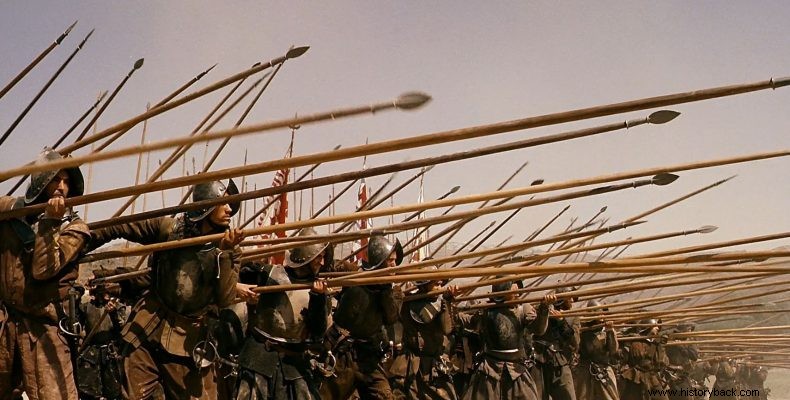
The sarissa was a long spear. It was born very early, as far back as prehistoric times and equipped the Minoan and early Achaean pedestrians in the form of "sound". The main difference between the sarissa and the spear was its length, which required the use of both hands of the warrior to use it.
Generally speaking as sarissa any spear longer than 3 to 3.5 m was characterized. The spear rarely exceeded 2.5 m in length and the warrior usually held it with one hand. The first phalanxes of sarissaphoros date back to the Minoan and early Mycenaean era.
The sarissas of the time, the so-called enghi, were about 3.5 m long and were included in the arsenal of the warriors of the time as an antidote to the advances of the opposing chariots.
For a long time the sarissa was forgotten as a weapon. It came back into use in the "known world" under Philip II of Macedonia, although some analysts state that it was the Thebans of Epaminondas and Pelopidas who brought it back into use. Thanks to the sarissa, the new Macedonian phalanx managed to prevail over the traditional phalanx of satellite hoplites.
The Macedonian sarissa was twice as long as the longest spear, reaching or sometimes exceeding 6 meters. It consisted of two pieces connected by a brass joint and at the back it had a brass counterweight, which also functioned as a spare tip, the sweeper.
The sarissa remained the main weapon of the Greek armies until the Roman conquest of the Greek and Hellenistic states. The Romans fought in a completely different way until the end of their empire.
In Byzantium, however, the sarissa made a comeback, for a time, equipping the divisions of the heavily armed "scoutas" pedestrians mainly during the dynasty of the Isaurians.
However, in this case the Byzantines used their 3.5 m long sarissas mainly defensively, forming an impenetrable barrier of spikes for the opposing cavalry and infantry, supported closely by light infantry armed with small arms.
The sarissa again disappeared from the battlefields of Europe at least until the 13th century AD. It gradually came back to allow the infantry to face the formidable rival of the time, the knights.
The epic conflicts of the sarissaforous "citizens" of the Low Countries against the French knights, or of the Scots against the English, have been recorded. In theory the cavalry should have no hope of prevailing. However, the inexperience of the infantry defenders allowed the mounted warriors to score successes.
However, the triumphant return of the sarissa as the basic weapon of the infantry is recorded in the 15th century in Central Europe with the Swiss and the Germans taking the lead.
The sarissas of the time carried sarissas of about 5 m in length on average, with the Spanish initially choosing shorter weapons to gain in agility, but with tragic results. The men no longer carried shields like their ancient counterparts and wielded their sarissas with both hands, wielding them at great depth – up to 50 yoke, in the case of the Terthios.
The conflict between such rival phalanxes was a particularly bloody affair but soon ended with one side losing morale and fleeing.
After all, the sarrisophores were supported by men armed with lances or long swords that cut the opposing phalanx to the side. Gradually, mixed units of sarissaphores and crossbowmen or arquebusiers, or later musketeers, were developed, with the one covering the men armed with ebay weapons and the other weakening the opposing phalanx with their fire.
The sarissa continued to be used as a basic weapon to protect infantry from cavalry until the 18th century, while great generals such as Maurice of Saxony suggested, in the mid-18th century. its return to service as a critical weapon of the infantry fight.
In Napoleonic times, Prussian and Russian National Guard units were equipped with spears, mainly due to the lack of muskets, but also due to lack of training. The Prussians, however, at the first opportunity equipped these divisions with muskets.
Pantelis Karikas
